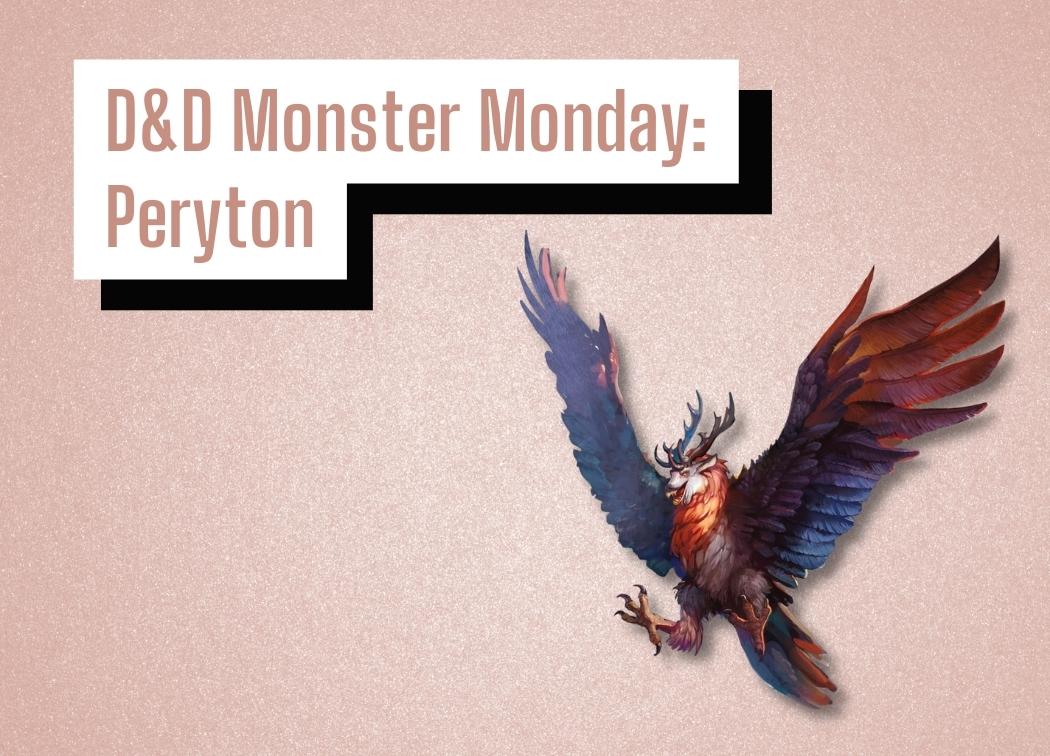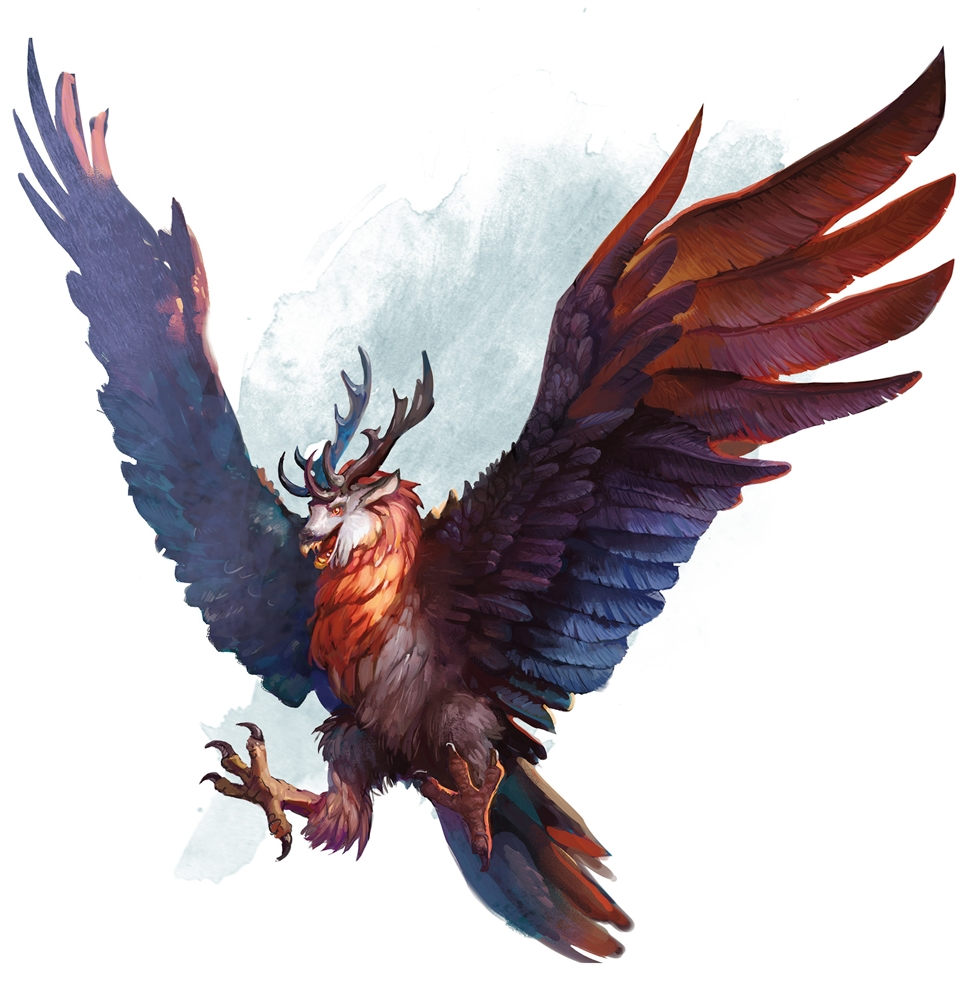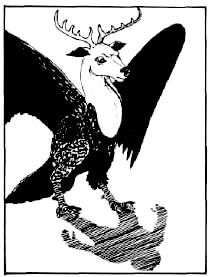D&D Monster Monday: Peryton

You watch in horror as out of nowhere your compatriot, Dathoridan, is run-through by a torrent of feathers. A sizeable hole is visible in his chest as he falls to the ground. A gleeful squawking is heard in the distance as a peryton flaps away with his heart.
Griffons are lovable, classic, fantasy creatures that rule the skies and often serve as noble steeds.
Perytons are the exact opposite in 5e lore. They’re ruthless hunters who desperately seek out humanoid flesh.
Best of all, their statblock backs up their lore of being ruthless mountain-dwelling hunters. Their ability to divebomb prey from the sky and gut them in one fell swoop is a thing of terror.
Let’s swoop into the Monster Manual and snack on a few elf hearts while we learn about the vicious mountaintop hunters, the perytons!

Peryton Lore
Perytons have conflicting origins. Some believe that the first perytons were humans transformed by a curse. Others believe that a woman ate the heart of her husband’s mistress to perform a ritual to win her husband’s heart. After she was hanged for this crime, the magic transformed her into the first peryton.
Regardless of their origin, these creatures are cursed to devour the heart of a freshly killed humanoid. It is an unnegotiable requirement because… reasons. I don’t know. It’s metal as fuck though so I’m down with it.
While peryton can consume any humanoid heart, they have a hankering for the hearts of elves, half-elves, and humans. Due to this, they’ll often make their nests near human or elvish settlements in and around the mountains. This gives them a clear view of an accessible and constantly-replenishing food source.
Peryton Stats and Abilities
You can find the peryton’s statblock on page 251 of the Monster Manual.
Stats
Size: Medium monstrosity
AC: 13 (natural armor)
HP: 33 (6d8 + 6)
Speed: 20 ft., fly 60 ft.
STR: 16 (+3)
DEX: 12 (+1)
CON: 13 (+1)
INT: 9 (-1)
WIS: 12 (+1)
CHA: 10 (+0)
There’s not much to write home about in this section of their statblock. Their Strength is solid which gives their attacks a respectable baseline.
Their Dexterity, Constitution, and Wisdom all have +1 modifiers which is a smidge above average for a CR 2 creature. +1 isn’t the greatest baseline for the most common saving throw abilities, but it’s at least a small bump for the majority of the game’s saving throws.
The only remarkable aspect of this portion of the statblock is their 60 ft. of flying speed. This generous amount of three-dimensional movement is a very useful tool for DMs with regards to positioning. For example, it’s useful for avoiding melee attackers’ devastating damage!
Resistances, Immunities, Saves, and Skills
Skills: Perception +5
Damage Resistances: bludgeoning, piercing, and slashing from nonmagical attacks
Senses: passive Perception 15
Languages: understands Common and Elvish but can’t speak
CR: 2 (450 XP)
Due to their need to devour humanoid hearts, the peryton needs to spot a viable target quickly and efficiently. +5 to Perception and a passive Perception of 15 absolutely fits this bill. Even stealthy humanoids may have trouble hiding from the peryton’s watchful eye.
Resistance to weapon attacks is a solid boon for a low-CR creature. Especially one with weak defenses like the peryton. While it still has plenty of openings and weak points, this does help to plug one of the leaks in the hull.
CR 2 is a fair assessment. The peryton is frontloaded in its offenses, but I don’t mind that. I like hard-hitting creatures. They make for deadly and quick combat encounters which is the perfect recipe for a random encounter while traversing a mountain pass.
Traits and Abilities
Dive Attack. If the peryton is flying and dives at least 30 feet straight toward a target and then hits it with a melee weapon attack, the attack deals an extra 9 (2d8) damage to the target.
Flyby. The peryton doesn’t provoke an opportunity attack when it flies out of an enemy’s reach.
Keen Sight and Smell. The peryton has advantage on Wisdom (Perception) checks that rely on sight or smell.
Dive Attack is similar to the minotaur’s Charge trait. Albeit that it requires the peryton to fly instead of run and it doesn’t knock the creature prone. Still, it’s an extra 9 average damage per turn that the peryton can easily obtain thanks to Flyby allowing it to swoop in and out of the enemy’s reach without a care in the world.
One thing to keep in mind is that Dive Attack procs off of either Gore or Talons. This allows the peryton to use Multiattack and have two chances of dealing the additional 2d8 damage. It’s more consistent than the minotaur’s Charge, but it does lack the crowd control and movement displacement.
Keen Sight and Smell further enhances the peryton’s gifted perception. It was already tough for creatures to avoid this hunter’s gaze. It’s nigh impossible now.
Actions
Multiattack. The peryton makes one gore attack and one talon attack.
Gore. Melee Weapon Attack: +5 to hit, reach 5 ft., one target. Hit: 7 (1d8 + 3) piercing damage.
Talons. Melee Weapon Attack: +5 to hit, reach 5 ft., one target. Hit: 8 (2d4 + 3) piercing damage.
The peryton’s Multiattack includes two attacks which is a bog-standard action economy. The Multiattack deals an average of 15 piercing damage between the two attacks. Although that quickly jumps to 24 piercing damage per Multiattack when including Dive Attack.
Both attacks are unremarkable. They’re just basic attacks with no extra flair or any added effects. However, the +5 to hit is a hefty attack bonus for a CR 2 creature!
All in all, there’s nothing interesting going on here, but their offenses are both powerful and consistent.
Peryton Strengths
High-Powered Offense
Their Multiattack and Dive Attack combine to pump out an average of 24 piercing damage per turn. This is above average for a CR 2 creature and should be regarded as such.
We can safely include Dive Attack as a consistent damage booster due to Flyby preventing the provocation of attacks of opportunity, so there’s no reason to not dive, attack, and swoop back up to dive again.
Only crowd control or the Sentinel feat can stop these “birds” of prey from divebombing for extra damage.

Magnificent Movement and Maneuverability
60 ft. of movement is spectacular. Especially when said movement is in the form of a unique movement type like flying. Flying is powerful because it adds an additional axis to the battlefield.
Flying creatures can swoop behind cover such as trees or glide behind a hill to break line of sight. They’re not limited by obstacles on the ground either, allowing them to take a more direct path to their target (in general).
Not only this, but Flyby gives the peryton additional freedom of movement as they no longer need to worry about attacks of opportunity. They can weave-in-and-out of battle fluidly.
Peryton Weaknesses
Mediocre Defenses
Their saving throws aren’t bad, and they do have some valuable damage resistances, but the peryton is still a defensively-weak creature.
13 AC is pitiful making them an easy target. Especially since the peryton’s favored locations are mountains, cliffs, and other such open areas. Ranged attackers can pick off these creatures as soon as they come into view.
Crowd control is also an issue. While they are slightly above-average with regards to the three commons saving throw ability modifiers, if they fail a crucial saving throw they lose much of their power.
These creatures need to keep moving to deal extra damage. They become much less scary when they can’t do so.
Easy Target in Open Air
Low AC can be mitigated via the battlefield. For example, utilizing cover gives a creature a sizeable buff to their AC.
However, the peryton generally will not have this option. Especially if you are playing them in their favored locales. They’re creatures that want to spot out their prey, and hit them quickly before they can take cover.
This is an effective strategy due to their high damage output. Although, it also makes them sitting duck for ranged attackers. 13 AC and 33 HP also makes them very easy targets for said ranged attackers to blast them out of the sky.
How to Play a Peryton
Keep Moving
Almost 40% of their average damage per turn comes from Dive Attack. Ergo, if the peryton is not able to lean on this trait it’s doing noticeably lower damage.
Therefore, keep moving!
Leverage flyby and the peryton’s 60 ft. of flying speed per turn to swoop back up to an appropriate diving position after it attacks. This ensures that the creature can continue to add Dive Attack’s extra damage while still having plenty of room to position outside of enemy melee units’ reach.
Perytons are intelligent enough to know when a target is too much for them. If the battle isn’t going in their favor, consider retreating. A Dash action to retreat gives the peryton 120 ft. of flying speed in a single turn to quickly retreat. They can safely flee from most low-level adventuring parties within 2 rounds.
Hit Hard and Hit Fast
Perytons’ high damage output and weak defenses mean that they are best used quickly and efficiently. They won’t survive a 10 round slugfest, but they’ll be a deadly foe in a 2-3 round skirmish.
Have your perytons divebomb the party and smash into them. Keep up the assault by diving in and out of combat with flyby. From there, make a judgment call. If your perytons are healthy, keep fighting, otherwise, retreat.
Their high Perception is useful after they retreat. They can continue to monitor the party’s movements as they heal up and can swoop down for round 2 once they’re better prepared.
5 Peryton Plot Hooks
- A Terrified Settlement – A human settlement at the base of the mountain has been assaulted by perytons for the past week. Settlers are dying and supplies cannot make it safely to the town due to these ever-watching hunters.
- Getting to the Bottom of This – Conflicting lore and information has prevented scholars from pinpointing the true origin of the peryton. One sage wishes to reveal the true origin of this monstrosity. Bring them a living specimin and you’ll be well-rewarded!
- Stop the Ritual – You watch in awe as a peryton swoops down and rips the heart out of a person’s chest. You know the creature is bringing the hear back to its lair to use in a mating ritual.
- Big Game Hunter – The antlers of a peryton are a prized decorative piece in this region. Plus, they’re a terror for the nearby colonies. Many collectors and craftsmen are eager to obtain antlers, claws, beaks, and other parts of these creatures to sell or use as materials.
- Unusual Sacrifices – A clan of corrupt druids is said to capture wanderers and tie them to stakes outside of peryton nests. They offer these people as sacrifices and hope the peryton see their clan in a favorable light.
Conclusions
I’m a sucker for creatures with flyby. It’s such a fun tool for high mobility creatures. Couple that with Dive Attack and you have a terrifying, high-octane predator that will surely scare the hell out of the party.
I like how they made a justification for why the peryton is inclined to hunt humanoids. It’s a unique tidbit of lore that sets them apart from similar creatures. Plus their conflicting origins give the DM plenty of freedom to incorporate their own flavor into their story if desired.
All in all, the peryton is an interesting creature with a well-defined niche. They’re high-powered, high mobility strikers who seek out easy prey where possible. They have key weaknesses that help balance them out, but they also have plenty of tools to hinder the party’s ability to utilize their weaknesses.
